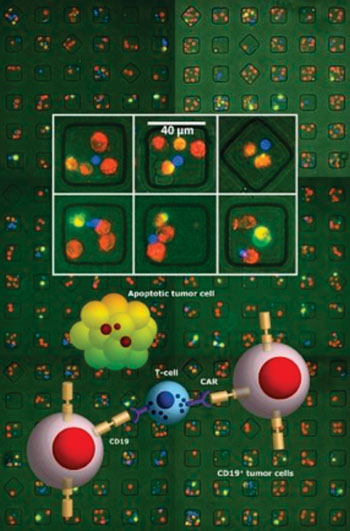Novel Algorithms Allow Automated Monitoring of Individual Cell-to-Cell Interactions
By LabMedica International staff writers
Posted on 25 Aug 2015
A novel combination of microscopy, time-lapse video recording, and analytical algorithms enables tracking of individual cell-to-cell interactions, which will boost research towards cancer immunotherapy treatments.Posted on 25 Aug 2015
The technique, Time-lapse Imaging Microscopy in Nanowell Grids (TIMING) was developed by investigators at the University of Houston (TX, USA) and their colleagues at the University of Texas M.D. Anderson Cancer Center. Studies using this method were carried out using fluorescently labeled human T-cells, natural killer cells (NK), and various target cells (NALM6, K562, EL4), which were co-incubated on polydimethylsiloxane nanowell arrays and imaged using multichannel time-lapse microscopy.

Image: Researchers used Time-lapse Imaging Microscopy In Nanowell Grids (TIMING) to demonstrate that CD4+ CD19-chimeric antigen receptor (CAR+) T-cells participate in multi-killing of tumor cells with slower kinetics of killing than CD8+CAR+T cells but high motility subgroups of both T-cell subsets have similar kinetics (Photo courtesy of the University of Houston).
Novel cell segmentation and tracking algorithms accounted for cell variability and exploited the nanowell confinement property to increase the yield of correctly analyzed nanowells from 45% (existing algorithms) to 98% for wells containing one effector and a single target, enabling automated quantification of cell locations, morphologies, movements, interactions, and deaths without the need for manual proofreading.
Automated analysis of recordings from 12 different experiments published in the June 9, 2015, online edition of the journal Bioinformatics demonstrated automated nanowell delineation accuracy greater than 99%, automated cell segmentation accuracy greater than 95%, and automated cell tracking accuracy of 90%, with default parameters, despite variations in illumination, staining, imaging noise, cell morphology, and cell clustering.
Example analysis revealed that NK cells efficiently discriminated between live and dead targets by altering the duration of conjugation. The data also demonstrated that cytotoxic cells displayed higher motility than non-killers, both before and during contact.
"We have developed a game-changing piece of software that can accurately analyze an entire grid of nanowell videos and make quantitative measurements," said senior author Dr. Badri Roysam, professor of electrical and computer engineering at the University of Houston. "It is essentially the combination of a supermicroscope and a supercomputer to screen cell-cell interactions on a large scale. The proposed algorithms dramatically improved the yield and accuracy of the automated analysis to a level at which the automatically generated cellular measurements can be utilized for biological studies directly, with little/no editing."
Related Links:
University of Houston
University of Texas M.D. Anderson Cancer Center







 assay.jpg)


 (3) (1).png)



